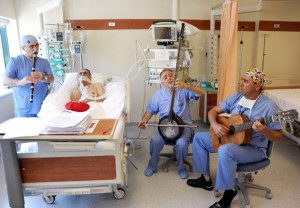If you have been following our blog, you will remember a post from a few weeks ago about art therapy. The short piece talked about art’s unique ability to transcend physical healing and address the multi-dimensional experience of chronic pain, specifically the emotional and psychological components. Music therapy is similar to art therapy in this way, in that its goal is to reach pain patients on an emotional and spiritual level in order to provide an alternative source for healing.
Music has always been important to humans; many music and sociology scholars argue that music is a fundamental aspect of human society—as integral as food, spoken language, family and ritual. Although music has transformed over time, what remains constant is its function as a community organizer, a signifier of meaning and a vessel of catharsis.
With this in mind, the concept of music as therapy is not hard to grasp; humans have been using it as such for thousands of years. Music comforts us through heartbreak, energizes us before important events, calms us during rush hour and unites us on the dance floor. It speaks directly to us in a language we can all understand.
Music therapy was formally introduced to America during World War II, when musicians began frequenting Veterans hospitals to play for soldiers who were suffering from PTSD and physical injuries. The positive results were immediately apparent, so hospitals began hiring musicians to be in-resident music therapists. Since then, pain management clinics and hospitals all across America have followed suit and harnessed the power of music by integrating music therapy as a complementary practice for their pain patients.
These are the specific goals of music therapy as outlined by Professor Suzanne Hanser from the Berklee College of Music:
- To direct attention away from pain or anxiety, distracting the listener with comforting music.
- To provide a musical stimulus for rhythmic breathing.
- To offer a rhythmic structure for systematic release of body tension.
- To cue positive visual imagery.
- To condition a deep relaxation response.
- To change mood.
- To focus on positive thoughts and feelings and to celebrate life.
Depending on the circumstances of the patient, music therapy can involve either listening to music, making music, or both. Unlike some other therapies, the goals and methods of professional music therapy are intricately individualized to the needs and abilities of the patient. Once the goals are set, the healing process begins.
Through music, the therapist accesses the patient in a way that no other doctor truly can. Especially in sessions of music making, in which the therapist has the capacity to interrelate with the patient and is in turn experiencing some of what the patient experiences.
Dr. Joanne Loewy is the director of the Louis Armstrong Center for Music and Medicine at Mount Sinai Beth Israel hospital in Manhattan. She passionately believes in the natural connection between music and the human body and the healing power of music on pain patients. She draws the connection between physiological processes like the beating of our hearts and the process of breathing as inextricably related to rhythm. In an interview for Pain Week she said: “Rhythm is essential to all the body’s systems. We need to realize that music can affect each of these systems independently and interchangeably”.
Music’s role in your pain management does not need to take the shape of professional therapy. By simply incorporating music –either playing or listening—into your daily schedule you may experience positive results .
As music therapist Lorrie Kubieck described it, “Physiologically and neurologically, music therapy is processed throughout your entire brain. It has this really great power on healing—emotional healing, physical healing, and social healing”. Music is connected to feeling, memory, imagery, heart rate and the breath, and in a therapeutically it can reduce discomfort from physical pain, anxiety, depression and simply make us feel happier. Music augments our sense of resiliency, and resiliency is arguably the most important quality to posses when living with chronic pain.
Resources:
- http://www.musicandmedicine.org/
- http://theacpa.org/uploads/Chronicles/chronicle_september2013_ONLINE_083113.pdf
- http://www.everydayhealth.com/pain-management/music-therapy-for-pain-management.aspx
- http://www.musictherapy.org/assets/1/7/MT_Pain_2010.pdf
- http://www.bostonmagazine.com/health/blog/2013/05/15/music-therapy/
Take the First Step Towards Pain-Free Living Today


